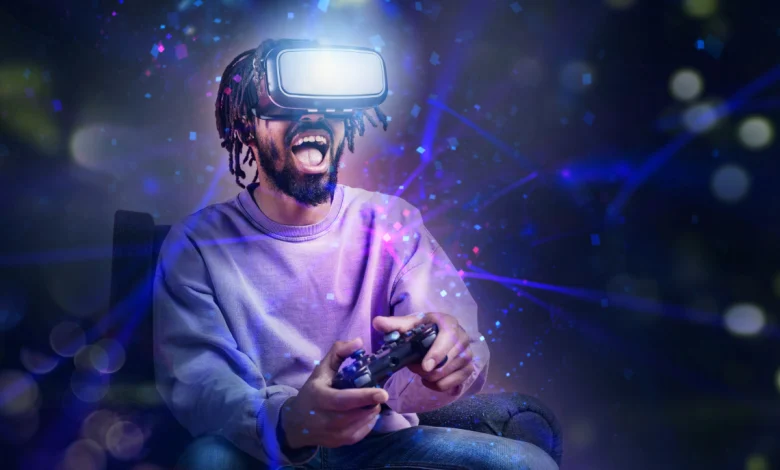How VR is Shaping Gaming

Introduction: The Rise of VR in Gaming
Virtual reality (VR) has made a massive impact on the gaming industry. Once seen as a futuristic concept, VR is now a thriving part of modern gaming. VR technology creates immersive environments that allow players to experience games in entirely new ways. From realistic visuals to interactive gameplay, VR offers gamers unique, engaging experiences. As VR advances, it continues to shape the future of gaming, influencing how games are created, played, and enjoyed.
A New Level of Immersion
One of VR’s most defining features is immersion. Unlike traditional games, VR surrounds players with a 360-degree environment, making them feel like they are inside the game.
1. Enhanced Visual Experiences
VR uses high-resolution displays and 3D graphics to create life-like worlds. In a VR game, players can see environments from multiple angles and feel as if they’re exploring real places. For instance, in a VR adventure game, players don’t just watch the action—they are part of it. These visual experiences add a new dimension to gaming that can’t be replicated on a screen.
2. Interactive Gameplay and Movement
VR also allows players to interact with the game physically. With VR controllers and motion sensors, they can move their hands, arms, and even walk in place. This interactivity makes VR games feel more engaging. In games like boxing simulators, players can throw punches, dodge, and block, creating a workout and gaming experience simultaneously.
3. Audio that Matches Reality
Immersive audio is another feature that enhances VR. Many VR headsets use 3D audio technology, making sounds come from specific directions. If something moves to the right, the sound shifts accordingly, creating a realistic audio experience. This audio immersion helps players feel as though they are truly inside the game world.

Social Interaction in VR Gaming
VR gaming is also shaping the way players interact with each other. Social VR platforms allow gamers to connect, play, and communicate in shared spaces.
1. Multiplayer VR Games
Multiplayer VR games allow players to team up or compete in virtual worlds. For example, VR games like “Rec Room” and “VRChat” enable players to join games, socialize, and even create their own worlds. These experiences are highly interactive, as players use avatars to represent themselves, adding a personal touch to online gaming.
2. Virtual Events and Meetups
Some VR games host virtual events, like concerts or tournaments, where players gather in the same virtual space. This trend became popular during the COVID-19 pandemic, as VR offered a safe way for people to connect. These events add a social element to gaming, making it more than just playing alone at home.
3. Building Online Communities
VR gaming also fosters community-building. Players can meet others from around the world, join groups, and make new friends. For instance, some VR platforms have clubs or communities for specific interests. Gamers can connect based on shared interests, creating friendships within virtual worlds.
VR Genres and Game Styles
VR is not limited to one type of game. Various genres are evolving specifically for VR, expanding options for players.
1. Adventure and Exploration
Adventure games are one of VR’s most popular genres. Players can explore new worlds, solve puzzles, and interact with characters as though they are on a real journey. Games like “The Elder Scrolls V: Skyrim VR” take players into expansive worlds full of mystery and excitement. This genre is perfect for VR, as it allows for immersive storytelling and exploration.
2. Simulation Games
VR has a strong presence in simulation games. Players can experience activities such as flying a plane, driving, or even working in a virtual office. Games like “Job Simulator” and “Beat Saber” give players unique experiences that mix realism with fun. These games let players try new things, making VR a great way to experiment with different activities.
3. Horror Games
VR adds a new dimension to horror games. When players are fully immersed, they feel more vulnerable to jumpscares and eerie environments. VR horror games like “Resident Evil 7” and “Phasmophobia” have gained popularity due to their intense, realistic experiences. VR horror can make even the bravest players feel fear, as the immersive environment intensifies the experience.
Advancements in VR Technology
The continued advancement of VR technology is shaping the future of gaming, providing gamers with better performance, visuals, and accessibility.
1. Improved VR Hardware
VR headsets are becoming lighter, more comfortable, and affordable. Early VR headsets were bulky, but recent models, like the Oculus Quest 2, have improved in size and comfort. Better hardware makes VR more accessible to gamers, allowing them to play for longer periods without discomfort.
2. High-Fidelity Graphics
Graphics in VR games are advancing quickly. As VR hardware improves, games can achieve higher visual fidelity. These improvements lead to sharper, more detailed environments that make games feel real. For instance, new VR games showcase detailed landscapes and textures that add realism to virtual worlds.
3. Increased Accessibility
Many developers are working to make VR more accessible. Some VR headsets no longer need to be connected to a powerful PC, making VR easier for more people to enjoy. Standalone VR headsets, such as the Meta Quest series, allow players to jump into VR without extensive setups. This accessibility makes VR gaming available to a broader audience.

Challenges and Limitations of VR Gaming
While VR gaming offers unique experiences, challenges remain.
1. Motion Sickness and Discomfort
Some players experience motion sickness during VR gameplay, especially with intense movements. Although developers are working on solutions, this remains an issue for some gamers. Techniques like reducing movement or offering stationary gameplay modes can help reduce discomfort.
2. Cost of VR Equipment
VR headsets and accessories can be expensive, limiting access to VR gaming. While prices are decreasing, high-quality VR systems still require an investment. However, as technology advances, prices may become more affordable, enabling more players to enjoy VR gaming.
3. Limited Game Selection
Although VR games are growing in popularity, the selection remains smaller than traditional games. Developing VR games requires unique skills and technology, making it more complex and costly. As more developers enter the VR market, the selection of games is expected to expand.
The Future of VR in Gaming
The future of VR gaming looks promising, with continuous improvements in technology and accessibility.
1. Cross-Platform Compatibility
Cross-platform compatibility allows VR games to be played with traditional gaming systems. For example, VR gamers can play alongside console or PC gamers in certain multiplayer games. This cross-platform feature makes VR more flexible and accessible, bringing gamers together regardless of the system.
2. Expanding VR Game Genres
More game genres will likely adapt to VR as developers explore its potential. We may see VR sports games, complex strategy games, or even educational games that teach skills. These new genres will expand the appeal of VR gaming, attracting diverse players.
3. Integrating AI and Machine Learning
AI can play a significant role in VR gaming. For instance, AI-driven characters could adapt to player actions, creating more dynamic experiences. Machine learning could also enhance visuals, generating environments that react to player movements and decisions.
4. Enhanced Social Interaction
The future of VR gaming will include more social features, allowing players to communicate, interact, and share experiences. As virtual worlds grow, players can engage in activities like virtual shopping, events, and even job experiences within games. VR could become a social platform where players not only game but connect on a deeper level.
Conclusion: VR’s Lasting Impact on Gaming
VR is transforming the gaming industry, offering new ways to experience games, socialize, and explore virtual worlds. From realistic visuals and interactive gameplay to social features and innovative genres, VR is reshaping gaming in exciting ways. While challenges like motion sickness and costs remain, advancements in technology promise to make VR gaming more accessible and immersive. As VR technology continues to develop, its impact on gaming will only grow, bringing us closer to an era where virtual reality is a standard part of gaming experiences.




